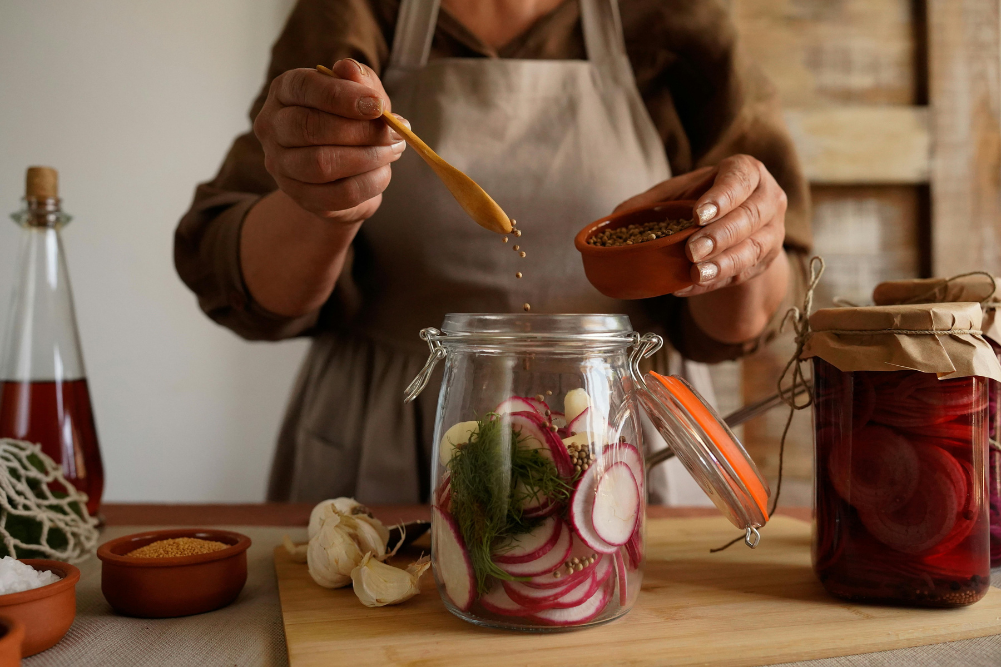8 simple steps to a more sustainable home
Retrofitting your home can make it more productive and resilient in an energy descent future. Environmental designer, ecological educator and author David Holmgren shares what you can do at the individual level.
David Holmgren and partner Su get most of their food from 120 fruit and nut trees, chooks and goats on their one-hectare property in Hepburn Springs, Central Victoria. Passive solar design, solar power, wood heating, cold-storage cupboards, composting toilets, grey water systems and other measures mean the couple have few household costs and a low impact on the environment. In a COVID-19 locked-down, energy descent and globally warming world, it’s a lifestyle many of us increasingly aspire to. “It takes a lot of work to keep it all ticking over,” Holmgren (the co-originator of permaculture), admits. “But no more hard work than the sort of things people pay money to do in a gym.”
Tours to Holmgren’s property, Melliodora (one of the nation’s best permaculture demonstration sites), are booked out. Holmgren believes the household non-monetary economy has suddenly become a priority for people. Feeding into this paradigm shift are the challenges of rising costs, shortages in energy, food and housing, economic recession and climate change. On average, our homes produce more than 18 tonnes each of greenhouse gas per year — over a fifth of Australia’s total contribution, according to the Environmental Protection Authority Victoria.
Modifying your behaviour is a central part of cultivating a more energy-efficient, self-sufficient lifestyle.
Holmgren, the author of RetroSuburbia: the Downshifter’s Guide to a Resilient Future, suggests refocusing our energy to become more self-sufficient. “The modern pattern of living and our economic system constantly reward and encourage us to give up whatever aspects of self-reliance we have and outsource it, because it seems easier,” he says. “That’s good for the GDP, but it actually makes people very vulnerable and dependent.”
Why retrofit?
We can’t all build a new, fully sustainable home or relocate to the country. Retrofitting (modifying what exists) allows you to make more achievable, smaller, incremental changes where you are, Holmgren says. It can be applied to apartment living, renting and suburban homes. It also avoids a lot of the regulatory impediments, he says. “You can actually do small changes and not need to get a permit. Organic, incremental, small changes at a time also allow us to learn from each step.” Rather than applying for a big loan, Holmgren suggests starting with what you can achieve yourself, and what you can modify for the most gain and least effort and expense.
Assess your situation
Analyse the property you live in as you would any business opportunity. “It’s a bit like a SWOT analysis of strengths, weaknesses, opportunities and threats,” Holmgren says. “Whether you own or rent, what are the opportunities? What are the hazards and key vulnerabilities you really need to address: the weak and strong points?”
RetroSuburbia includes many creative strategies for people to unite and share the labour, such as older people offering their gardens to younger folk renting down the road in exchange for crop sharing, multigenerational living and share housing.
To aid this complicated process, Holmgren developed the RetroSuburbia Real Estate Checklist (in the book and downloadable for free from retrosuburbia.com). Along with filtering out all the different things you need to consider, such as the regulatory freedom and climate of the area, available land, public transport access, soil fertility and house design, it helps people confront tougher decisions such as consolidating their household with others or moving. “You can be faced with decisions or realisations that are quite harsh,” he says. “But there is also that other side of people gaining huge boosts from what can be relatively small stepping stones or achievements.”
Retrofit your behaviour
A home isn’t just physical bricks and mortar, but how you do things within it. Modifying your behaviour is a central part of cultivating a more energy-efficient, self-sufficient lifestyle, Holmgren advises. Examples include things like washing your clothes less often and air-drying them, rising with the sun, cycling into town rather than driving or choosing to work fewer hours in a paid job in order to garden more. With the way humans live based on deeply entrenched habits and values, it takes conscious planning to change. Learning new “old” skills like sewing or food preserving is another part of adapting your behaviour.
Growing your household labour economy
It takes multiple people to cover the different roles of a household. “There’s these economies of scale that we usually think of as out in the big world; how big a farm needs to be to be viable or a corporation to survive in the world, but often it’s our households that are too small to be sustainable,” Holmgren says. “At the extreme a household is synonymous with a single person. That’s very unusual historically.”
RetroSuburbia includes many creative strategies for people to unite and share the labour, such as older people offering their gardens to younger folk renting down the road in exchange for crop sharing, multigenerational living and share housing. Holmgren rents his studio out to people who work on the property in exchange for accommodation.
Food self-sufficiency
Growing your own food and organising the garden and kitchen is a natural core to start with and huge driver of empowerment, Holmgren says. “Consider any capacity you have to produce, forage or exchange some degree of fresh food at home or in your neighbourhood.” Like our ancient ancestors, observe the local sources of sustenance in your environment. It’s things as simple as knowing where the overhanging fruit trees, wild foods and edible weeds are. “Beyond that, think of the exchange,” he says.
RetroSuburbia includes many creative strategies for people to unite and share the labour, such as older people offering their gardens to younger folk renting down the road in exchange for crop sharing, multigenerational living and share housing.
Connect to local growers, community-supported agriculture, food co-ops and farmers’ markets. “Almost anyone who grows food tends to have a surplus of something. There may be something you can do in exchange for that surplus,” he says. “Those sorts of connections may also be sources of knowledge to help you get started.”
Tailored to your own unique situation, garden retrofits might include removing unproductive species and replanting fruit trees, bringing in backyard chooks or beehives, installing drip irrigation, growing food in pots, raised beds, on the street verge or rooftop, starting compost, enriching barren soil, growing windbreaks or installing trellises.
On a behavioural level, Holmgren suggests shifting from the mentality that we’re eating at a restaurant. “Move away from the ‘What are we going to eat today?’ to ‘What have we got; what’s in the garden; what’s in the cupboard; what’s left over from yesterday?’ It’s not being so phobic about the expiry date, actually trusting your nose and building that confidence in the way we eat so food is less of a huge project,” he says.
Reduce the power bill
Cooking, heating water, keeping food cool, lighting the home and powering our electronics can be achieved in other ways besides the conventional use of electricity and gas, Holmgren says. The most popular alternative is solar power and solar water heating. But before forking out consider how much solar access you actually have. Whether you invest in solar or not, Holmgren suggests reducing power consumption with behavioural changes and alternative ways of doing things.
Wood combustion stoves can simultaneously be used to cook, warm the home and (if installed to do so) heat water. Another option are metal drum or rocket stoves. These are operated outdoors or on a balcony, and use tiny amounts of fast-burning stick fuel such as garden waste to boil a kettle or cook a meal. Charcoal barbecues are another option that be used on a balcony.
Other simple ideas for slashing energy consumption include old-fashioned clothes lines, switching to LED bulbs, portable DIY outdoor solar setups, solar hot water systems, solar lamps and low-energy induction hotplates for cooking.
Fridges are the second biggest drain on power, according to Dr Bruce Mountain, director of the Victoria Energy Policy Centre. In cooler climates it’s possible to create a “cool cupboard” in the shadier part of the house to store less perishable foods you might normally keep in the fridge. The cool cupboard draws cool air in from under the floor up into the cupboard, enabling you to have a smaller, less power-hungry fridge, Holmgren explains.
Heating and cooling
Heating and cooling our homes accounts for the biggest percentage of our power bills, Dr Mountain says. Small changes, like curtains, insulation, draught sealing, shade cloth, double glazing, external window and wall shades, painting the roof a light colour and passive solar design can make huge differences to thermal comfort and your energy expenditure.
To best benefit from passive solar design (taking advantage of a building’s site, climate and materials to maximise thermal comfort), ideally your home should be sited for sun to enter the building from the north, Holmgren says. Tweaks you can make include turning a sunny, north-facing bedroom into a living room. “Smart use of vegetation around the house can make a huge difference to both the heating and the cooling of the house,” he adds. “Just by happenstance it can also end up being a negative: shady in the wrong times or not getting the sun when you need it.” Plant deciduous trees or vegetation that loses its leaves in autumn around the home. This allows the sun through in winter (particularly critical in cold climates) but shades walls and windows in summer. A simple trellis structure on the west can be erected to grow annual food plants like pumpkins or beans and simultaneously protect the home from the western afternoon sun.
Tailored to your own unique situation, garden retrofits might include removing unproductive species and replanting fruit trees, bringing in backyard chooks or beehives, installing drip irrigation, growing food in pots…
For extra warmth, wood heaters can be installed relatively inexpensively, and provide economical heating if wood is sourced or scavenged from waste, recycling and tree removal. “Whereas a lot of people think wood is old-fashioned, polluting and bad for the environment, that’s mostly because we can see most of the adverse effects, whereas when we install our photovoltaic panels on the roof we don’t see the pollution in China that made those panels,” he says. “There’s still a lot of embodied energy in solar production.” He says wood from sustainable plantations that is dry, well seasoned, used in efficient equipment and burned in a more rural or regional town, is relatively low-polluting.
Harvesting rainwater
Most modern suburban homes can potentially collect a lot of rooftop water. “There’s actually an abundance of water in urban areas because all those hard surfaces don’t use any of the water that falls on them,” Holmgren says. The downside is that storage is expensive, bulky and less convenient than mains water.
Water tanks come in many sizes and materials, including plastic, stainless steel, galvanised iron and concrete. If you’re going to use the water you capture to drink, he suggests opting for a stainless-steel tank. However, plastic versions are easier to move around and come in more flexible shapes for confined spaces. (If you live in a bushfire-prone zone, remember that plastic melts!)
Ponds, rain gardens and swales (which direct and funnel run-off to where you need it in the garden) are other ways you can capture rainwater for irrigation.
Reusing waste
Grey water (waste water from the kitchen, laundry and bathroom excluding human manure) is another potential resource of water for the garden, with the advantage you don’t have to wait for rain. The cleanest water to reuse is from the shower, Holmgren says. He suggests avoiding recycling water from the kitchen. Any reuse of grey water needs to involve minimising chemical cleaning and personal care products: the chemistry in soaps and detergents is harmful to soil microbes. Fats are also detrimental to soil health.
Recyclable DIY waste systems at home range from the simple — like composting kitchen scraps, mulching your own chip bark from woody garden trimmings and using a pee bucket or wheelie bin compost loo — to installing a compost toilet or grey water diverter in the plumbing. It’s also possible to buy off-the-shelf grey water treatment and filtering systems. But with mains water relatively cheap it’s hard to justify buying such products, Holmgren says.
Another option for treating grey water (used at Melliodora) is a stepped bath system. It purifies waste water in three successive stages — via a worm farm, reed bed and finally an open pond, which overflows into the garden. If you don’t have old baths to use, any large containers will do, he says.
Even little changes can increase the resilience of your household. A by-product of becoming more self-sufficient is your own increased psychological wellbeing, Holmgren says. “Doing sensible, useful things, even if it’s only partial, simple or at a symbolic level, gives you a sense of control. Just putting seeds in the ground and eating something within a few weeks of sowing is a transformative experience of some degree of autonomy and self-reliance.”
Connect to the RetroSuburbia community
Website: retrosuburbia.com
Facebook: facebook.com/RetroSuburbia
YouTube channel: RetroSuburbia








